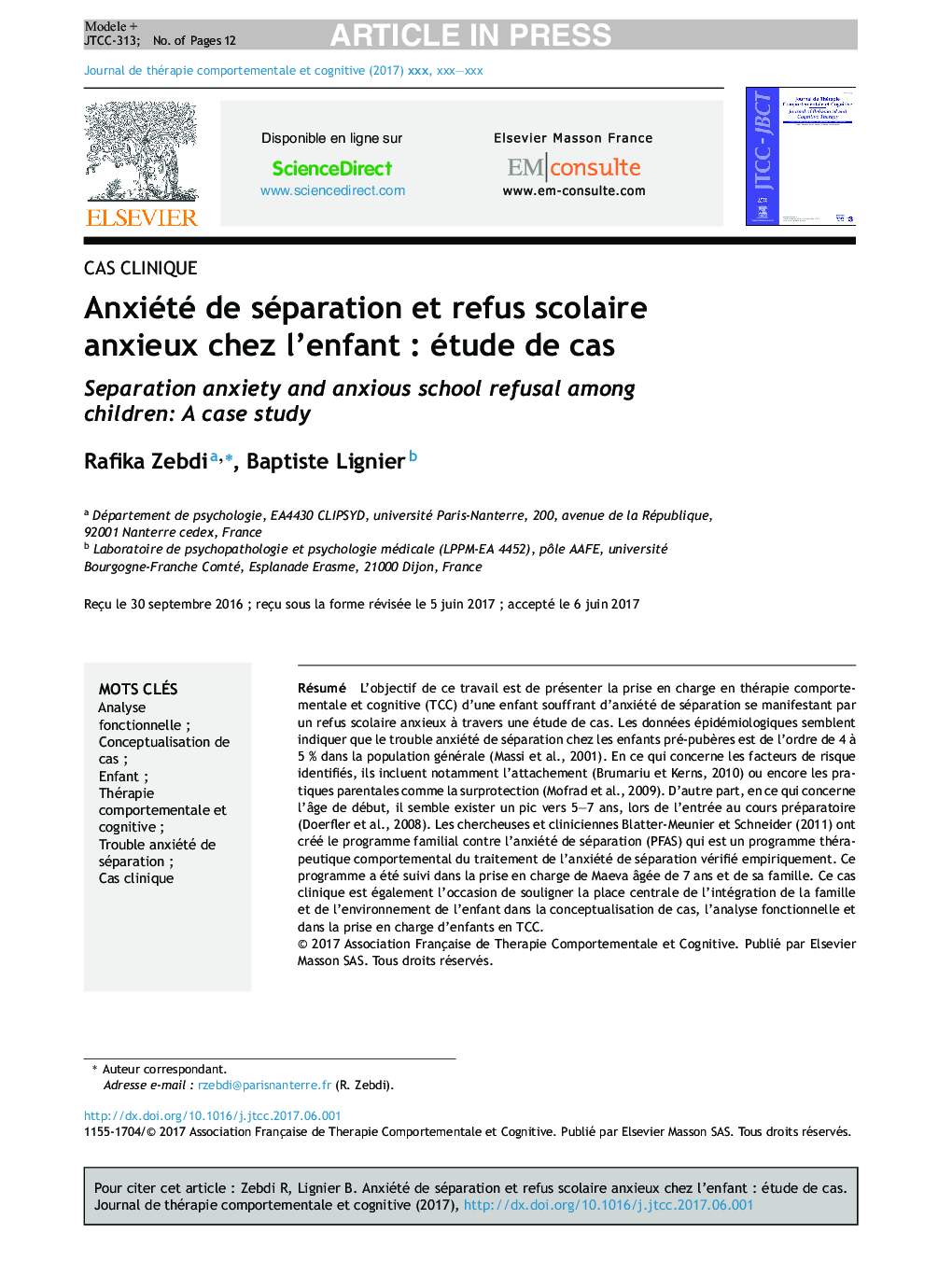| کد مقاله | کد نشریه | سال انتشار | مقاله انگلیسی | نسخه تمام متن |
|---|---|---|---|---|
| 7298213 | 1474756 | 2017 | 12 صفحه PDF | دانلود رایگان |
عنوان انگلیسی مقاله ISI
Anxiété de séparation et refus scolaire anxieux chez l'enfant : étude de cas
دانلود مقاله + سفارش ترجمه
دانلود مقاله ISI انگلیسی
رایگان برای ایرانیان
کلمات کلیدی
Functional analysis - آنالیز تابعیseparation anxiety disorder - اختلال اضطراب جداییAnalyse fonctionnelle - تجزیه و تحلیل عملکردSingle case - تنها موردThérapie comportementale et cognitive - درمان رفتاری شناختیCBT - رفتار درمانی شناختی case conceptualization - مفهوم سازی موردCas clinique - مورد بالینیChild - کودکEnfant - کودک
موضوعات مرتبط
علوم پزشکی و سلامت
پزشکی و دندانپزشکی
روانپزشکی و بهداشت روانی
پیش نمایش صفحه اول مقاله

چکیده انگلیسی
The aim of this study was to present the cognitive-behavioral therapy of a child with a separation anxiety disorder and severe school refusal behavior. Epidemiologic studies suggest that anxiety separation disorder in pre-pubescent children affects between 4 to 5% of the general population (Massi et al., 2001). The identified risk factors include attachment (Brumariu and Kerns, 2010) or parental practices such as overprotection (Mofrad et al., 2009). The researchers and clinicians Blatter-Meunier and Schneider (2011) created the family program against separation anxiety (PFAS) which is an empirically verified behavioral treatment of separation anxiety. The first four sessions contain psychoeducation about the difference between normal anxiety, pathological anxiety and anxiety during child growth. The child begins to develop positive thoughts against fear and anxiety. It also provides the opportunity to explore the child's personal experiences about the disappearance of fear, to talk about other situations and to identify avoidant behaviors and parental dysfunctional thoughts which could maintain fear of separation. Then, the child and their family choose anxiety exposition situations and the active phase of the therapy begins. This program was followed in cognitive-behavioral therapy with Maeva, a 7-year-old girl and her family. Maeva was a smiling and joyful girl when she was with her mother. As soon as her mother left the room, she became anxious, bit her nails, asked the time and pretended to have something to find in her mother's handbag. According to her mother, Maeva never slept alone. She used to sleep with her parents and she had slept with her grandmother since her grandfather had died. Severe separation anxiety began at the same time as her parent's separation. For six weeks, Maeva had cried every morning in front of the school and entered the classroom late. Crying fits lasted longer and longer and Maeva was unable to participate in learning and class activities. The psychotherapist used the Screen for Child Anxiety Related Emotional Disorders (SCARED; Birmaher, 1997), the Children Depression Inventory (CDI; Kovacs, 1981, 1992), the Schedule for Affective Disorders and Schizophrenia for School-Age-Children Present and Lifetime version (Kiddie-SADS-PL; Puig-Antich and Chambers, 1978), behavioral observations from Maeva's mother and teacher and the Situations Ãmotions Cognitions Comportements Anticipations (SECCA; Cottraux, 1990) to assess psychopathological disorders and to do the functional analysis and case conceptualization. Maeva and her mother quickly and actively adhered to this program. The girl no longer worried about separation and going to school. She gained autonomy and maturity. Indicators used to assess symptoms and behaviors before, after and two months after the therapy decreased considerably. The overall improvement in total anxiety was 55% and 66% about separation anxiety. Social interactions were no longer a problem. The main difficulty was to plan sessions with Maeva's grandmother who was constantly unavailable. Maeva's parents were asked to become mediators between therapy and the grandmother. They had to include the grandmother in exercises at home and to teach her psychoeducation elements they had seen in sessions. This case also provided an opportunity to highlight the importance of including family members and the child's environment in case conceptualization, functional analysis and the child's individual care in cognitive-behavioral therapy.
ناشر
Database: Elsevier - ScienceDirect (ساینس دایرکت)
Journal: Journal de Thérapie Comportementale et Cognitive - Volume 27, Issue 4, November 2017, Pages 165-176
Journal: Journal de Thérapie Comportementale et Cognitive - Volume 27, Issue 4, November 2017, Pages 165-176
نویسندگان
Rafika Zebdi, Baptiste Lignier,